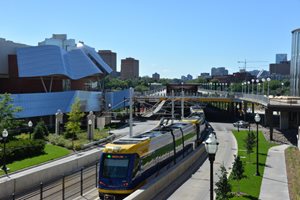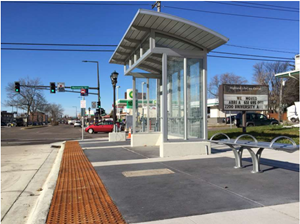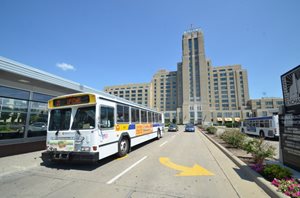Transit Systems Development (TSD)

Transit Systems Development (TSD) at Metro Transit oversees the planning, design, engineering, and construction of major transitway projects, including light rail transit (LRT). Due to the size, complexity and interdisciplinary nature of these projects, Metro Transit establishes project offices that include staff from the Metropolitan Council, Metro Transit, MnDOT, counties, and consultants. This coordination can result in improvements to pedestrian access as well as better opportunities for TOD or Joint Development.
What we do to support TOD:
-
We develop the Land Use and Economic Development sections of the application to the Federal Transit Administration for transitway funding.
-
We educate communities, property owners, and developers about TOD.
-
We analyze land along the transitway and work with local governments and developers to identify opportunities for future development.
-
We work with Engineering and Facilities at Metro Transit on how to consider existing and future development in the design and function of transit facilities (e.g., pedestrian access and visibility of waiting areas).
-
We work with Local Planning Assistance in the Community Development Division to evaluate and recommend changes to local comprehensive plans and policies to support TOD.
More information:
METRO Green Line Extension (Southwest Corridor)
METRO Blue Line Extension (Bottineau Corridor)
METRO Gold Line (Gateway Corridor)
Bus Rapid Transit Projects (BRT)

The BRT Projects Office at Metro Transit plans and implements bus rapid transit (BRT). BRT includes features that are similar to light rail transit (LRT), but are in corridors that are not candidates for LRT. Corridors planned for BRT have high current bus ridership, and run along corridors where additional development is likely. Riders pay fares at stations before boarding. Shelters feature amenities, such as heating and information on arrival times. BRT stops less frequently and travels faster than local buses. In some cases, BRT may travel along rights-of-way that are reserved for transit and/or carpools. In other cases, streets may be modified to make it easier for buses to operate (e.g., stopping in the travel lane with a curb extension rather merging into and out of traffic).
What we do to support TOD:
-
We work with planners and economic development staff in cities to evaluate the potential for TOD, including how different routes or station locations would best connect transit riders with destinations.
-
We work with property owners and developers to ensure the compatibility of BRT stations with adjoining development, considering the impacts of waiting areas, streetscape, and access for transit riders, pedestrians, residents, and customers.
-
We help MnDOT, counties, and cities with the design and engineering of roadways to meet the needs of future BRT stations and operations.
-
Engineering and Facilities at Metro Transit helps us develop plans for BRT stations.
More information:
Metro Transit Bus Rapid Transit Projects
Facilities Planning
 Facilities Planning at Metro Transit plans improvements or changes to facilities that support the transit system. Facilities include bus stops, shelters, BRT stations, LRT stations, commuter rail stations, transit centers, bus garages, and park-and-rides. These facilities are also part of the community and can help attract and serve TOD.
Facilities Planning at Metro Transit plans improvements or changes to facilities that support the transit system. Facilities include bus stops, shelters, BRT stations, LRT stations, commuter rail stations, transit centers, bus garages, and park-and-rides. These facilities are also part of the community and can help attract and serve TOD.
We consider how well facilities will function and how they affect public infrastructure and surrounding land uses. We evaluate how shelters and landscaping will work for people boarding and exiting transit. We also review private development plans and give feedback on how they might affect or could benefit the transit system.
What we do to support TOD:
-
We develop and implement policies about the allocation and timing of investments that support transit operations, transit rider needs, and community needs.
- We develop guidelines for our larger proposed facilities that give direction for more detailed work on design and engineering.
-
We provide feedback on proposed development site plans and public spaces, and we suggest changes that could improve transit operations and service.
-
We collaborate with owners and developers of adjoining property on the design of transit facilities.
-
We review local street reconstruction projects and suggest changes that make it easier or quicker for buses to operate.
-
We collaborate with Field Operations and Service Planning at Metro Transit to better understand how existing conditions might affect decisions about facility location and design.
-
We collaborate with Transit Service Development and the BRT Projects Office at Metro Transit on the design of transit stations.